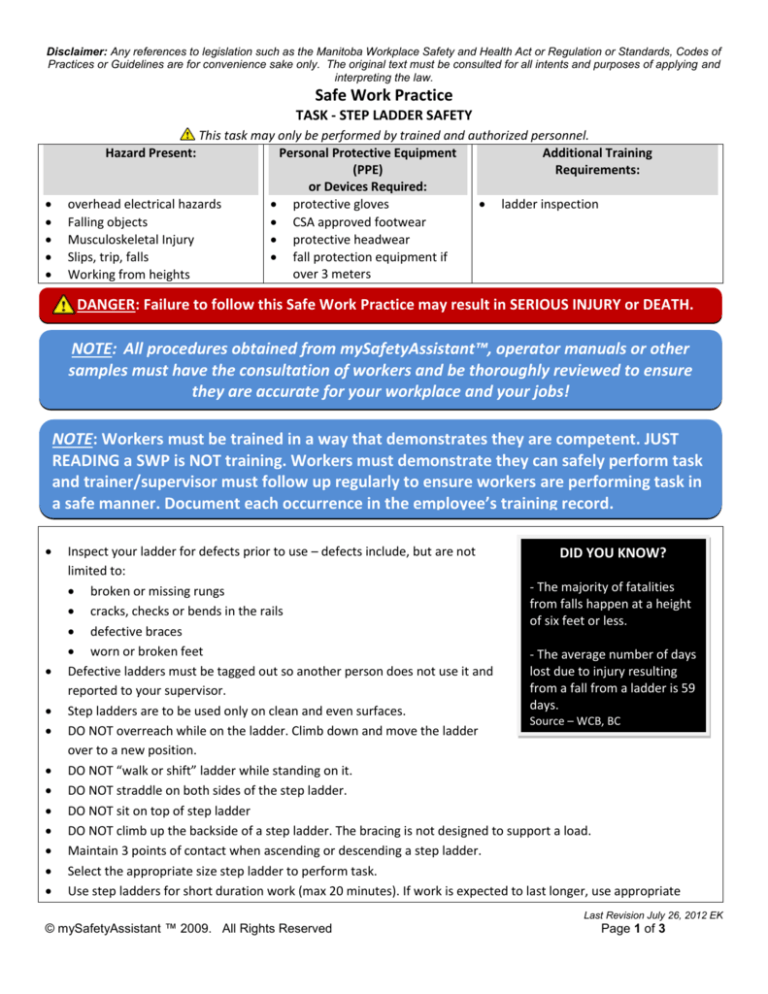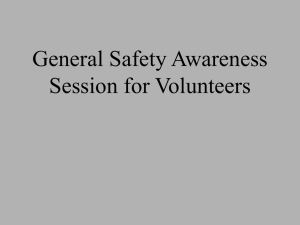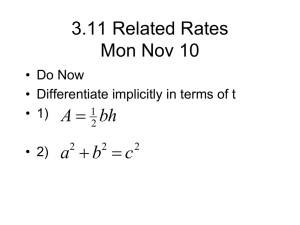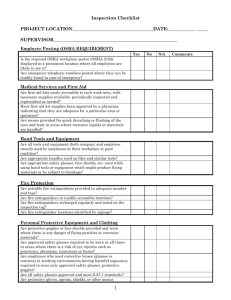
Disclaimer: Any references to legislation such as the Manitoba Workplace Safety and Health Act or Regulation or Standards, Codes of
Practices or Guidelines are for convenience sake only. The original text must be consulted for all intents and purposes of applying and
interpreting the law.
Safe Work Practice
TASK - STEP LADDER SAFETY
This task may only be performed by trained and authorized personnel.
Hazard Present:
Personal Protective Equipment
Additional Training
(PPE)
Requirements:
or Devices Required:
overhead electrical hazards
protective gloves
ladder inspection
Falling objects
CSA approved footwear
Musculoskeletal Injury
protective headwear
Slips, trip, falls
fall protection equipment if
over 3 meters
Working from heights
DANGER: Failure to follow this Safe Work Practice may result in SERIOUS INJURY or DEATH.
NOTE: All procedures obtained from mySafetyAssistant™, operator manuals or other
samples must have the consultation of workers and be thoroughly reviewed to ensure
they are accurate for your workplace and your jobs!
NOTE: Workers must be trained in a way that demonstrates they are competent. JUST
READING a SWP is NOT training. Workers must demonstrate they can safely perform task
and trainer/supervisor must follow up regularly to ensure workers are performing task in
a safe manner. Document each occurrence in the employee’s training record.
Inspect your ladder for defects prior to use – defects include, but are not
DID YOU KNOW?
limited to:
- The majority of fatalities
broken or missing rungs
from falls happen at a height
cracks, checks or bends in the rails
of six feet or less.
defective braces
worn or broken feet
- The average number of days
lost due to injury resulting
Defective ladders must be tagged out so another person does not use it and
from a fall from a ladder is 59
reported to your supervisor.
days.
Step ladders are to be used only on clean and even surfaces.
Source – WCB, BC
DO NOT overreach while on the ladder. Climb down and move the ladder
over to a new position.
DO NOT “walk or shift” ladder while standing on it.
DO NOT straddle on both sides of the step ladder.
DO NOT sit on top of step ladder
DO NOT climb up the backside of a step ladder. The bracing is not designed to support a load.
Maintain 3 points of contact when ascending or descending a step ladder.
Select the appropriate size step ladder to perform task.
Use step ladders for short duration work (max 20 minutes). If work is expected to last longer, use appropriate
Last Revision July 26, 2012 EK
© mySafetyAssistant ™ 2009. All Rights Reserved
Page 1 of 3
Disclaimer: Any references to legislation such as the Manitoba Workplace Safety and Health Act or Regulation or Standards, Codes of
Practices or Guidelines are for convenience sake only. The original text must be consulted for all intents and purposes of applying and
interpreting the law.
equipment (scissor lift, rolling scaffold, aerial lift).
Check the grade (ie 1, 2 or 3) to unsure it is appropriate for use
Grade 1 – Construction and Industrial (heavy load rating, 250lbs)
Grade 2 – Tradesman and Farm (medium load rating, 225lbs)
Grade 3 – Household (light load rating, 200lbs)
DO NOT use metal/aluminum ladders when performing electrical work.
Maximum height of step ladders when set cannot exceed 6 metres
Face ladder when climbing up or down.
DO NOT overload ladder. Check maximum working load on marking/sticker.
Use step ladders in the fully opened position with the spreader bars locked.
DO NOT use tops of step ladders as a support for scaffolds.
Use only CSA / ANSI approved ladders.
Workers are prohibited from:
working from the top two steps of a step ladder unless the ladder is designed for it or it is equipped with a
railed platform
using metal ladders near any exposed energized electrical circuits or equipment
using a ladder on a scaffold or other elevated surface
having more than one person on a ladder at a time
using homemade ladders
using a step ladder as a straight ladder
NOTICE: Report all hazardous situations to your supervisor without delay!
Guidance Documents / Standards/ Applicable Legislation
/Other:
Guidance Documents:
Operator’s Manual
CSA Standards
CSA CAN3-Z11-M81 (R2011) Portable Ladders
ANSI Standard A14.1-2000, American National Standard
for Ladders — Wood — Safety Requirements,
ANSI Standard A14.2-2000, American National Standard
for Ladders — Portable Metal — Safety Requirements,
ANSI Standard A14.5-2000, American National Standard
for Ladders — Portable Reinforced Plastic — Safety
Requirements; and
Manitoba Workplace Safety and Health Regulation, MR
217/2006 as amended:
Part 2.1 Safe Work Procedures
Part 6.1 Personal Protective Equipment
Part 8 Musculoskeletal Injuries
Part 13.11-19 Portable Ladders
This Safe Work Practice will be reviewed any time the
task, equipment, or materials change and at a
minimum every three years.
Completed / Approved By:
Date Completed:
SWP Last Reviewed / Revised by and date:
Last Revision July 26, 2012 EK
© mySafetyAssistant ™ 2009. All Rights Reserved
Page 2 of 3
Disclaimer: Any references to legislation such as the Manitoba Workplace Safety and Health Act or Regulation or Standards, Codes of
Practices or Guidelines are for convenience sake only. The original text must be consulted for all intents and purposes of applying and
interpreting the law.
Part 14.6-23 Fall Protection
This Safe Work Practice has had the consultation of the following workers:
Name_______________________ Signature ______________________ Position _________________
Date: ___________
Name_______________________ Signature ______________________ Position _________________
Date: ___________
Name_______________________ Signature ______________________ Position _________________
Date: ___________
Last Revision July 26, 2012 EK
© mySafetyAssistant ™ 2009. All Rights Reserved
Page 3 of 3








